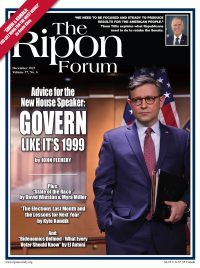
The 2024 presidential election is about to begin. Republican voters in Iowa, New Hampshire, Nevada, and South Carolina will be the first to decide who gets to take on President Joe Biden in the general election. Polls presently indicate that the contest will be a rematch between Biden and former President Donald Trump. The likelihood of a Biden-Trump matchup is driving many Americans to support third-party candidates instead of the Democratic or Republican tickets. The fractured field and the fact that Biden is trailing in several key states suggests that Trump could again prevail in the Electoral College while failing to win the national popular vote. This prospect is likely to spark a debate over how Americans elect the president of the United States.
Most Americans want to abolish the Electoral College. According to a recent PEW Research Center survey, approximately two-thirds of Americans favor using the national popular vote to elect the president. That number is likely to grow in the event of another Electoral College popular vote split. And the fact that the Electoral College disadvantages third-party candidates suggests that their supporters will be more likely to back efforts to abolish it.
But abolishing the Electoral College would be a mistake. It helps make American self-government work. The Constitution’s structure prevents a concentration of power in any one branch of the federal government. Changing it to use the national popular vote to elect the president instead of the Electoral College allows for a greater concentration of power in the executive branch.
Abolishing the Electoral College would be a mistake. It helps make American self-government work.
The delegates to the Federal Convention of 1787 who wrote the Constitution wanted to empower the federal government while ensuring it could not use its power to become tyrannical. The delegates understood tyranny as “the accumulation of all powers, legislative, executive, and judiciary, in the same hands, whether of one, a few, or many.” To prevent tyranny, they divided the government into three branches. The delegates reasoned that doing so would make it harder for any one branch to amass all of the government’s power effectively.
Preserving the Constitution’s separation of powers requires that each branch of the government be independent. One way the Constitution achieves this separation in practice is to ensure that each branch has “as little agency as possible in the appointment of the members of the others.” Generally, “all the appointments for the supreme executive, legislative, and judiciary magistracies should be drawn from the same fountain of authority, the people.” There are, however, exceptions to this general rule. The people can also be tyrannical. Making each branch of government directly dependent on the popular will will eliminate any obstacle to the concentration of power in their hands. The Constitution itself was ratified, in large part, to solve the problems created by unchecked popular power at the state level during the 1780s.
The people already elect the president indirectly. According to Rufus King, “It was with the people that the Constitution meant to place the election of the Chief Magistrate.” The Constitution’s Electoral College Clause (Article II, section 1, clause 3) stipulates that electors from each state shall elect the president. And its Presidential Electors Clause (Article II, section 1, clause 2) empowers each state to determine its process for selecting presidential electors. State legislatures initially chose presidential electors. However, most states adopted popular election of presidential electors in the 1810s and 1820s. South Carolina was the last state to adopt the popular election of presidential electors in 1868.
In contrast, delegates to the Federal Convention explicitly rejected allowing the people to elect the president directly. Charles Pinkney argued that “an Election by the people” was liable “to the most obvious & striking objections.” Among them was the possibility that “the most populace States” would combine “in favor of the same individual.” Pinkney warned that this would make the president an elective monarch, which he considered “the worst kind.” James Madison worried that a popularly elected president would be more likely to neglect smaller states’ interests or sacrifice them altogether. Popular majorities in the larger states could use the presidency to infringe on the rights of individuals and minorities more easily in their states. To prevent this scenario, the Constitution limits the number of electors each state can appoint “to the whole Number of Senators and Representatives to which the State may be entitled in the Congress.”
Delegates to the Federal Convention explicitly rejected allowing the people to elect the president directly.
To be fair, those opposed to the popular election of the president could have been wrong, or things may be different today. Americans have amended the Constitution to make it more democratic. For example, the 17th Amendment abolished the direct election of senators and adopted popular election instead. But doing so did not fundamentally alter the Senate’s ability to check the House. The Senate is structured differently than the House. And Congress isn’t capable of unitary action like the president. Abolishing the Electoral College, however, would change the structure of the presidency to make it easier for popularly elected presidents to concentrate power in the executive branch.
Presidents may claim they have a popular mandate to implement their agenda over the objections of Congress and the courts. But the fact remains that a majority of the Electoral College elect’s presidents, not a majority of all Americans.
Abolishing the Electoral College in favor of the popular vote would strengthen a president’s claim to speak for a majority of the American people.
Free governments have fared poorly historically when challenged by a powerful – and popular – executive. American self-government has survived because the Constitution makes it harder to destroy it.
James Wallner is a senior fellow at the R Street Institute, and published author. Previously, Wallner was the Group Vice President for Research at the Heritage Foundation. He spent over a decade on Capitol Hill earlier in his career working in senior positions in both the House of Representatives and Senate.




